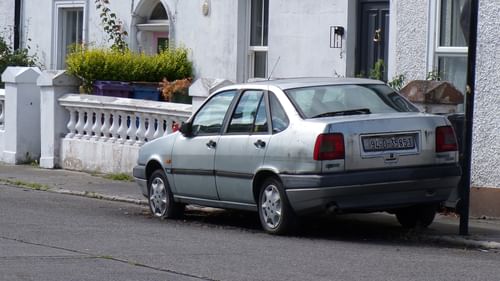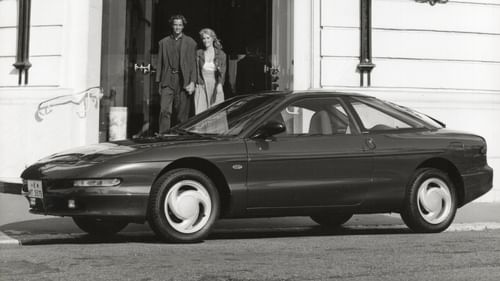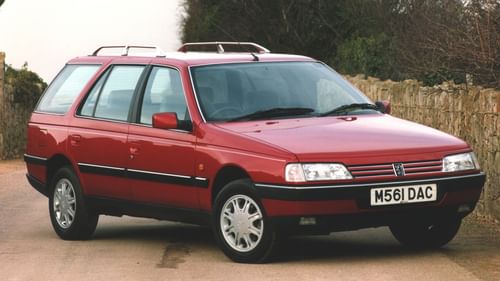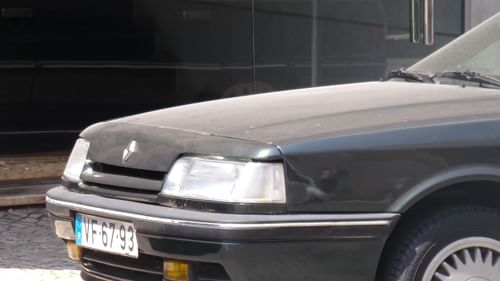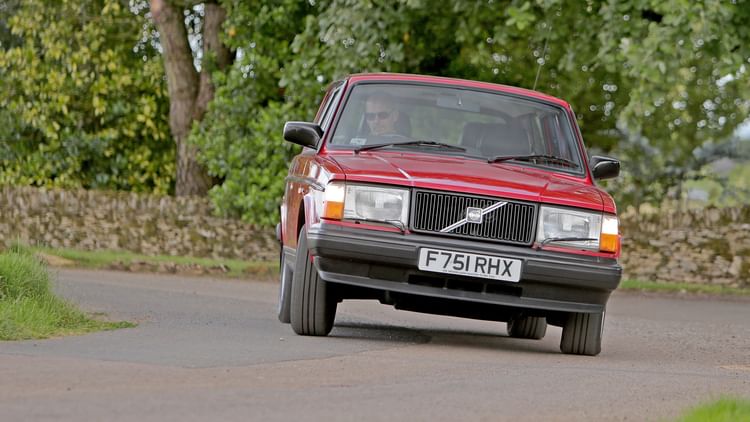
Tick tock, tick tock, tick tock, tick tock… It’s the sound that greets you if you turn the key in the ignition without belting up. The frantic ticking, akin to the pulse of a Volvo that’s just engaged in a strenuous workout, is accompanied by a red flashing light to leave you in no doubt that you should consider fastening your belt before hitting the road.
We didn’t know it at the time, but the clock was counting down to the end of Volvo’s status as a purveyor of boxy estate cars. When news broke on social media, it was as though the country had lost a national treasure; we half expected the imminent announcement of a day of mourning. Once the dust had settled, and the knee-jerkers had realised that this was a UK-only announcement, and saloons and estate cars would still be available to the emergency services, people began sharing memories of Volvo estate cars, particularly the 240. If your parents didn’t own one, you almost certainly had an aunt or uncle who did. And if not, it was your geography teacher, or the chap down the road who ran an antiques business. Maybe it was the painter and decorator, gardener or plumber, who took advantage of the 240’s tank-like robustness and IKEA store-rivalling load area once it was no longer considered de rigueur to park the big Swede on the pea shingle outside the des res in the home counties or Surrey commuter belt. The 240’s transition from middle class stalwart to working class hero was smoother than the patter of the aforementioned antiques dealer.
How many boxes can we tick on our patented Volvo Cliché Bingo Card? Antiques dealer – ding! Tank-like – ding! IKEA – ding! Boxy – ding! We’ll need to add a few others, such as Golden Retriever, Hunter wellies and The Good Life before we can shout ‘Swedish FULL HOUSE Mafia’. Give yourself a bonus point for ABBA; the winner takes it all in this game.
By the time F751 RHX was registered in March 1989 by Lex Brooklands of Mayfair, it was becoming an antique in its own right. Launched in 1974 – the same year that ABBA (ding!) won the Eurovision Song Contest and Björn Borg (ding!) achieved his first Grand Slam tournament title – the 240 was essentially a development of the 140, which debuted in 1966. The 240 should have faced its Waterloo (ding!) in 1983-84 to free up capacity for the 740/760, but although it escaped the øx (ding!), its days at the sharp end of Volvo’s focus were over. In 1988, Volvo formed a company within a company to handle 240 operations, with a team of 50 people employed to see the car through to retirement; the final 240 rolled off the Torslanda production line five years later. The appropriately named Volvo Torslanda had debuted in 1991: a classic run-out special with alloy wheels, decals, roof rails and matt-black trim. All this for a bargain £13,300, or around £30,000 in today’s money, money, money (ding, ding, ding, ding and ding!).

Was it really a bargain? Even in 1985, the 240 DL finished last in a Motor five-way group test against the Austin Montego, Peugeot 505 Family, Vauxhall Carlton and Volkswagen Passat. The mag labelled it ‘a huge and competent cargo carrier’, arguing that it offered the ‘best metal-for money’. At £9017, the 240 undercut its rivals by a considerable margin, but was let down by its handling, thirst and interior.
By then, 240 estate production had peaked at 85,729 in 1983-84, and, aside from a brief upturn in 1991-92, would continue to fall year-on-year (see separate panel). Total production for the entire 240/260 range hit 2,862,573, making it Volvo’s most successful model to date. Given the global obsession with SUVs, we can say with a level of confidence to rival Zlatan Ibrahimovic (ding!) that it will remain Volvo’s best-selling estate car for eternity.
Not bad for a car that, aside from a couple of facelifts and the odd nip and tuck here and there, lived largely unaltered for nineteen years. With styling influenced by the VESC (Volvo Experimental Safety Car) of 1972, the 240 – initially called the 244 (saloon) and 245 (estate) – was an evolution of the 140. Indeed, the cars shared the same platform and were essentially identical from the scuttle back, with Volvo shifting to MacPherson struts and rack-and-pinion steering. This was also the dawn of the legendary ‘Redblock’ engine (the old units were simply red blocks), with single overhead cam replacing the old pushrod configuration, along with an aluminium rather than an iron head.
Crucially, the 240 was even safer than the 140 – probably the safest family car in the world – with the US impact bumpers and lattice head restraints the most visible reference points for the enhanced safety credentials. Other upgrades include improved rear suspension, wider track at the front than in the rear, wider tyres and an upshift in interior quality. Good enough to take the car into the 1980s, but nobody could have predicted that it would live on until 1993.

Because the 240 Turbo was never sold here, the GLT is arguably peak Volvo 240 in the UK. We’ll save the ‘flying brick’ story for another blog post, but it’s worth noting that, at its launch in 1981, the road-going 240 Turbo could sprint to 60mph in nine seconds and hit a top speed around 120mph, making the estate version the fastest wagon in the world. This was a big statement for Volvo, especially in the days before the performance estate car was a thing. The company had come a long way since the launch of its first estate in 1953; Volvo named it the Duett because it was two cars in one: workhorse during the week and leisure pursuit vehicle at weekends.
The GLT lacked the performance of the Turbo – not to mention the association of success in the 1985 European and German Touring Car Championships – but it certainly looked the part. It arrived in 1980 as the 244 GLT, billed as ‘the first performance car that’s as safe as a Volvo.’ No other manufacturer could squeeze the most out of the safety message quite like Volvo…
Who needs ETC and DTM pedigree when you can call the cops for some performance credentials? While the lesser models made do with a 2.1-litre four-cylinder unit, the GLT drew power from a 2.3-litre unit developed for the police. The 92.0mm bore of the 2.1 was opened up to 96.0mm, with the stroke remaining at 80.0mm to give a capacity of 2315cc; the compression ratio was increased from 9.3 to 10.0 to 1. Alterations to the single overhead, belt-driven camshaft profiles pushed peak horsepower and torque higher up the rev range to produce 140bhp at 5750rpm and 140lb ft at 4500rpm. For reference, the 2.1’s figures were 123bhp at 5500rpm and 125lb ft at 3500rpm respectively. Early cars had the option of a four-speed manual gearbox with overdrive or a four-speed automatic. Low-profile Pirelli P6 tyres, gas-filled dampers, 15-inch alloys, front lip spoiler and a near-complete absence of brightwork completed the transformation from staid to sporting.
GLT (Grand Luxe Touring) sales continued until 1990, which makes F751 RHX one of the last cars to be sold in the UK. It’s also likely to be one of the best, having just 45,000 miles on the clock and one previous owner before it was placed in the care of the Volvo’s UK heritage fleet. The original owner – who ran it as a company car before buying it from the lease company – used it as a second car and went to great lengths to preserve it in showroom condition. Floor trays to protect the carpets, then carpets on top to protect the floor trays; protection for the door pockets to stop them from getting scratches; never taking it out in the rain…

You can imagine our feeling of guilt when the near-perfect GLT emerges out of the back of a former Cazoo delivery lorry to be greeted with a leaden sky and the threat of thundery showers. That threat soon turns to reality as the Volvo is subjected to more rainfall in one night than we suspect it has seen in 34 years. At least the hot-dip galvanised metal parts and underseal are finally being put to good use; with apologies to the original owner.
Our rendezvous with the photographer requires a relatively early start and 150 miles of mostly motorway driving. It’s also our first opportunity to spend time admiring the car without getting drenched. Only the staunchest Volvo apologist would call it beautiful, but the 240 has more charm than most modern cars can only dream of. Maybe it’s the familiarity of the shape or the whiff of nostalgia, but the 240 looks friendly and unintimidating. It’s also big, even by today’s standards; you could polish off your 10,000 steps simply by walking around it. Your eyes are drawn to the comically long side windows flanking the load area; ordering a 240 in special-order black would have been a brave choice, unless you were moonlighting as a funeral director.
Red isn’t an obvious choice for a large estate car, but it contrasts well with the black trim and highlights the Virgo alloy wheels. We’d say something about red cars being faster, but that would probably send the cliché-o-meter into a tailspin. Besides, despite what Volvo said, the GLT is no performance car…
The driver’s door shuts with a reassuring clunk, and we remember to buckle up before we twist the key. Twist the dial to turn on the radio, and we’re greeted with the sound of A-ha’s “Take On Me”. If Morten, Mags and Paul had formed a band 50 or so miles to the east of Oslo, we could have been celebrating an epic score on our Volvo Cliché Bingo Card. As it is, we’re left hunting high and low for our next ‘ding’.

If only the B230E engine was as tuneful as a Norwegian pop group. It fires up with all the willingness of a teenager when they’re asked to tidy their room, before settling down to a rough idle and a sense that it will return to its slumber without a blip of the throttle. Doing so makes the entire car rock from side to side, making you feel like you’re sat in an American muscle car, only without the muscle. It would be wrong to label it ‘agricultural’, but by 1989 the engine and its surroundings were certainly showing their age.
The inside is a sea of black, punctured only by the white headlining and red seatbelt warning light. If Lovejoy is wondering where he left his leather jacket, he should look no further than the gear lever gaiter, while the buttoned leather seats would grace the reception area of any firm of architects. Although lacking in initial comfort, over time they mould to the shape of your bottom like a pair of Skechers on your feet. We switch on the seat heaters for an extra layer of comfort; try doing that in your £100 slip-ins.
There’s only so much a Chesterfield can do to protect your posterior from the potholes and pockmarks of the nation’s road network. The ride quality is unexpectedly harsh, a by-product of the un-Volvo-like (for the time) low-profile tyres and larger wheels. Driving over sunken drain covers sends vibrations through the cabin, and although the seats cushion you from the impact, the Golden Retriever (ding!) in the boot would thank you carrying a padded dog bed.
We’re ashamed to admit that, after the first hour behind the wheel, we were questioning the 240’s national treasure status. A car that felt special in the 1970s was beginning to feel unacceptable in the ’80s. While the car’s load-carrying credentials remained intact, the world had overtaken the 240, which was lost in the wilderness between mainstream and premium. Keen drivers with deep pockets would prefer a BMW, while those in search of comfort would turn to Mercedes-Benz; canny buyers would opt for the Volkswagen Passat. Granted, this is an overly simplistic analysis, but the fact remains: the 240 was struggling to remain relevant. Stopping for a McDonald’s flat white on the M5 we’re left feeling… flat. Oh dear; knocking the 240 is like saying something bad about Dame Judi Dench or Stephen Fry.
Don’t worry, there’s a ‘but’ coming up.

The longer you spend in the company of a 240, the more it makes sense. It’s not quick, but that’s hardly the point of the car, even if the GLT makeover hints at a sporting character. Squeezing the best out of the engine requires effort, but it’s the torque that impresses the most; it pulls strongly in every gear, even from low revs, continuing to surge forward with gusto to the 6000rpm redline. Handy if you’re carrying a wardrobe, grandfather clock or Dame Darcey Bussell statue. The gear change is long but reassuringly mechanical, and a joy to use with all that torque at your disposal. As a later GLT, it has the K rather than the H cam, which means 135bhp is being sent to the rear wheels. It rolls when cornering like you’d expect a Volvo of this vintage to roll, while the car’s tendency to understeer informs you that it’s time to back off. The 240 GLT responds well to be driven at 90 percent; stay well within its limits and it becomes a loyal and willing companion.
Then there’s its classlessness. By luck, we chance upon a £3m house in the Cotswolds for our shoot, and thanks to the generosity of its owner, Nick, we discover that even after 34 years, a Volvo 240 still manages to look at home parked outside a palatial country pad. Less The Good Life and more To the Manor Born. Not many cars of this era would look good in the photos of a Knight Frank or Savills brochure, but the 240 looks as at home here as a pair of dungarees on Felicity Kendal.
We take the long way home, playing dot-to-dot with the sleepy towns and villages of the West Country, before driving into the sunset on the A303 and A30. As night falls, it’s easy to imagine a dozing spouse on the passenger seat, two children tucked up beneath a tartan blanket in the back, and a dog in the boot, surrounded by the luggage for a family holiday by the coast. This is the reason why parents chose the 240 over supposedly superior rivals, even in its advancing years. That intangible sense that you’ve done the right thing; prioritising safety, dependability and robustness over all else.

It's also something this 240 GLT is lacking: character. The car is too perfect. Where’s the faded GB sticker on the boot, which comes with memories of that family holiday in Antibes? What happened to the Swiss vignette in the corner of the windscreen, recalling the skiing trip in 1992 when your daughter broke her ankle. Where’s the dent on the passenger door, which took the shine off your son hitting his first boundary at the village cricket club? Where are the stone chips on the bonnet, the dog claw scratches on the rear bumper, the boiled sweet stains on the rear bench, and the old Happy Eater travel map in the glovebox? The Volvo 240 estate, perhaps more than any other car of the 1970s and ’80s, was a car designed, not only to be driven, but to be at the centre of everything you do. With the exception of a proper Land Rover, no other car rocks the lived-in look quite like a 240. It was never the quickest, the most comfortable or the quietest of family cars, but it would do its best to get you to your destination, regardless of the weather and whatever you throw at it. Three decades on from its demise, the 240 still leaves you with the sense that it will outlive humanity. Cars don’t enjoy a 19-year production run by accident; the 240 wormed its way into our affections with its honesty, durability and an intangible greatest that its rivals couldn’t deliver.
For years, Volvo didn’t just build estate cars, it built the estate car. The clock is ticking if you want to order a new one in the UK, but fear not, because the old ones were built to last, and if this 240 GLT is anything to go by, they will still be running long after the sands of time have run out. We’re save the debate about its national treasure status for another day, but we can all agree that the 240 is a timeless classic.
This article first appeared in issue 24 of Classic.Retro.Modern. magazine. Photos by Magic Car Pics.
